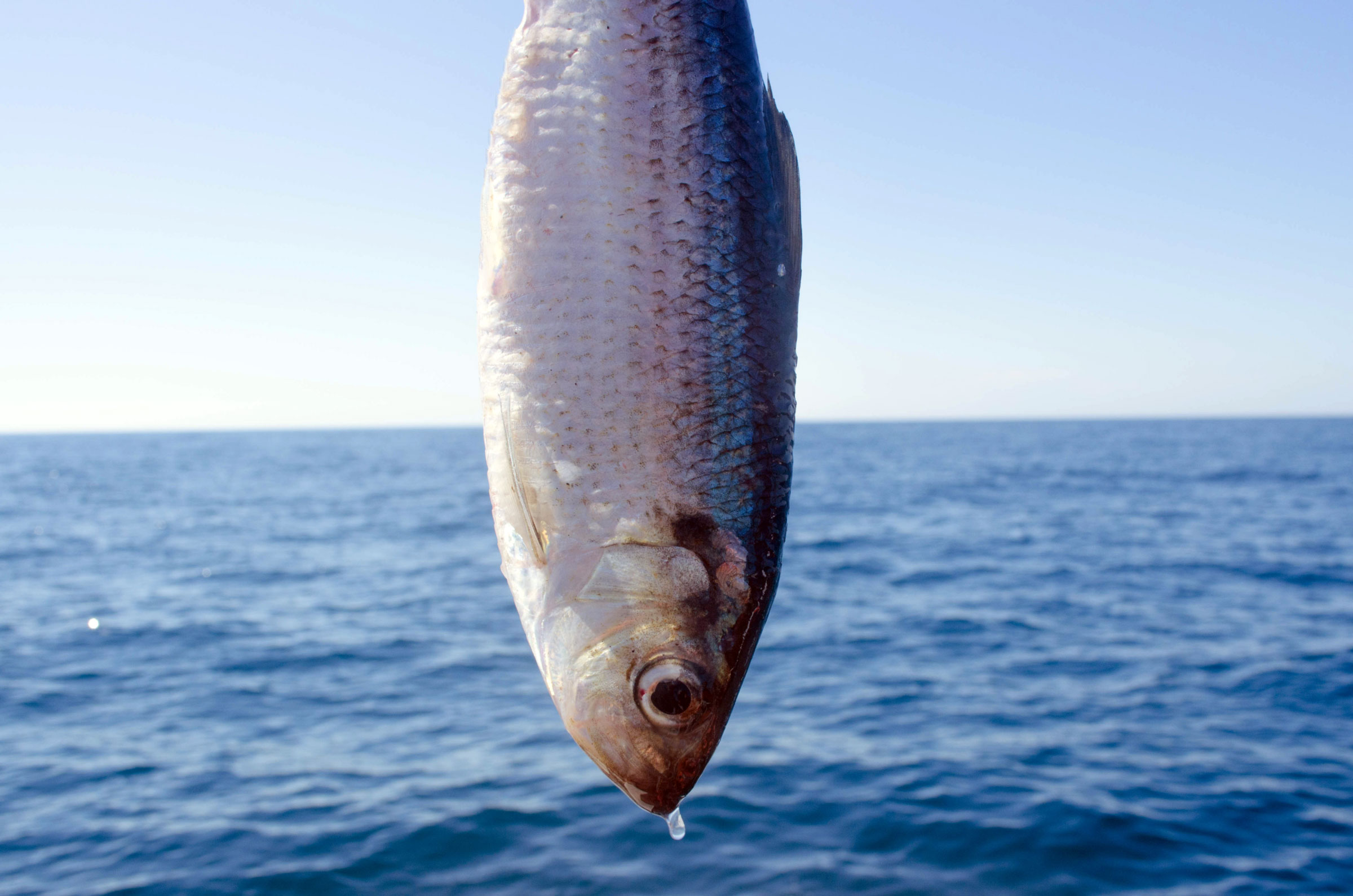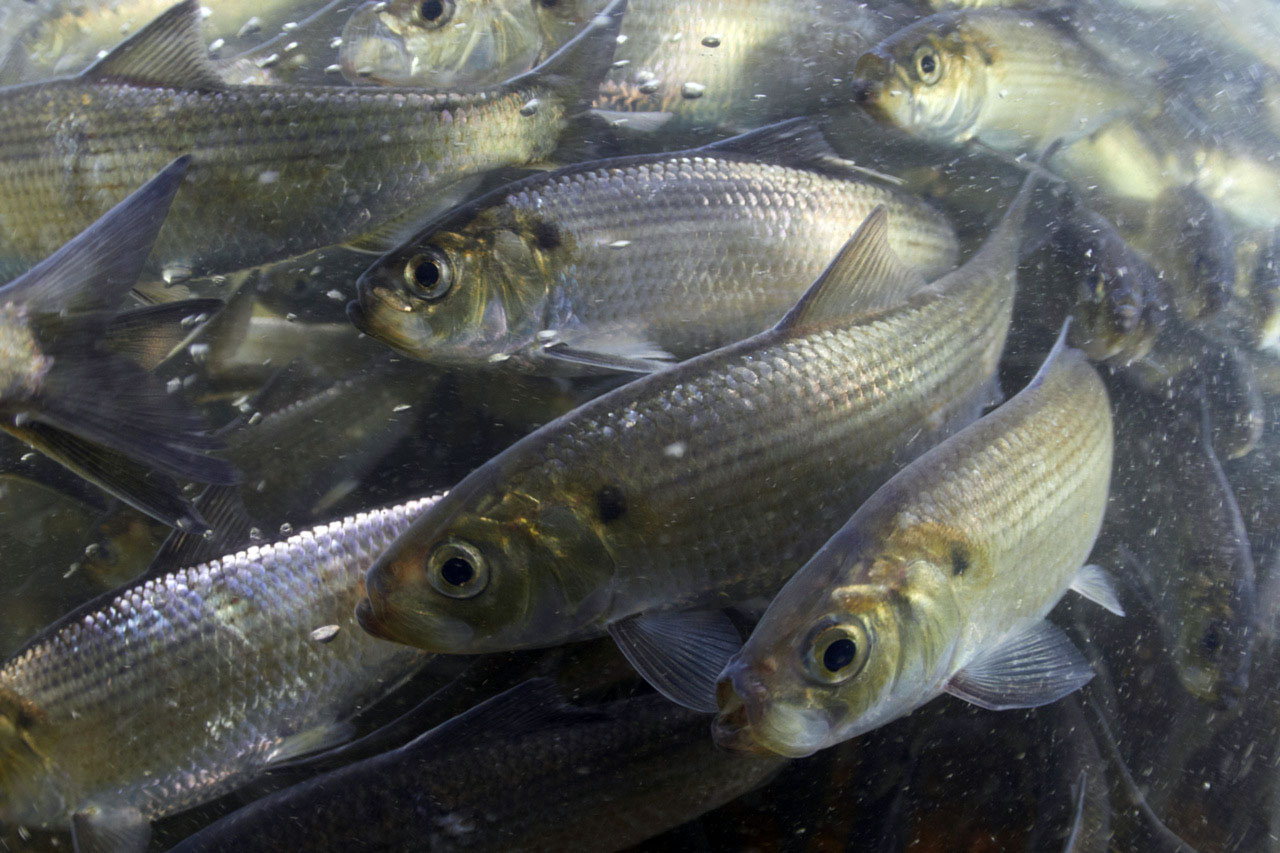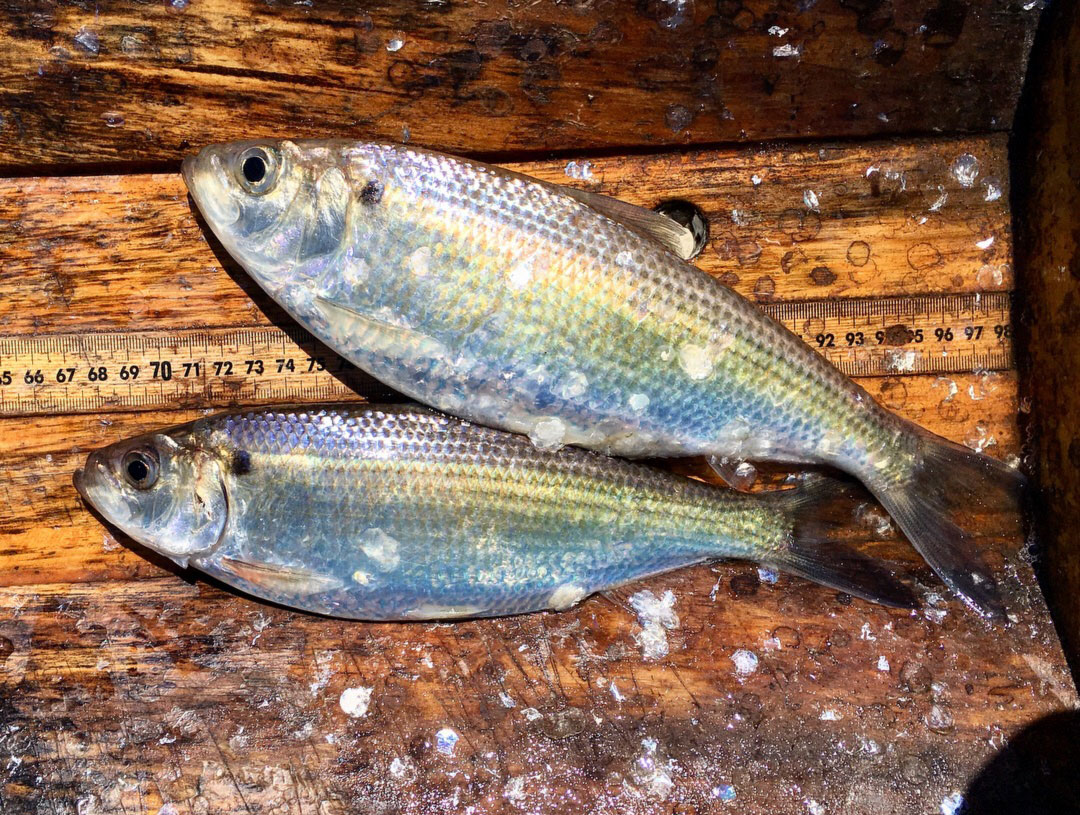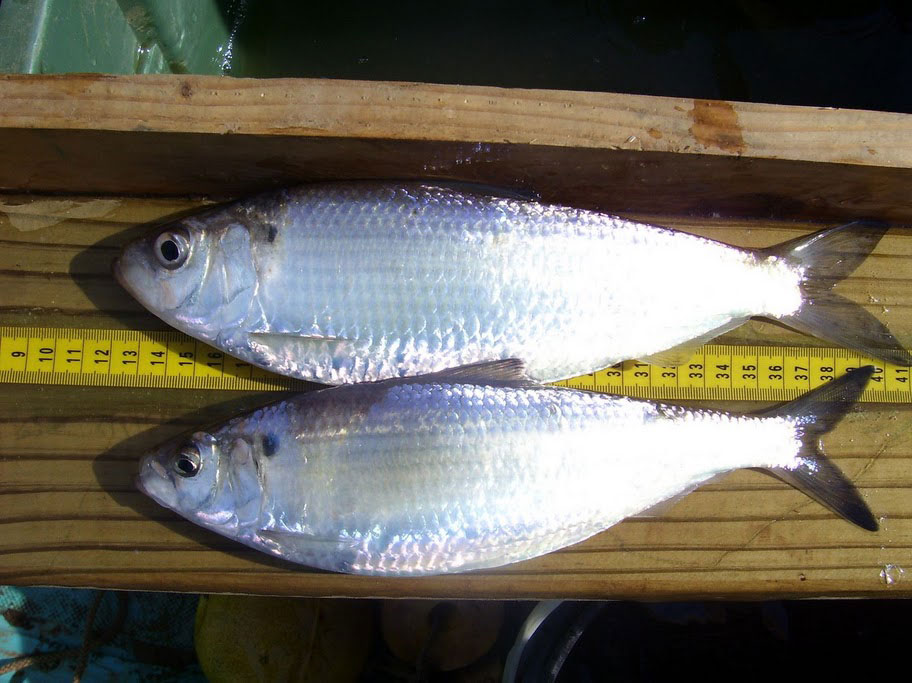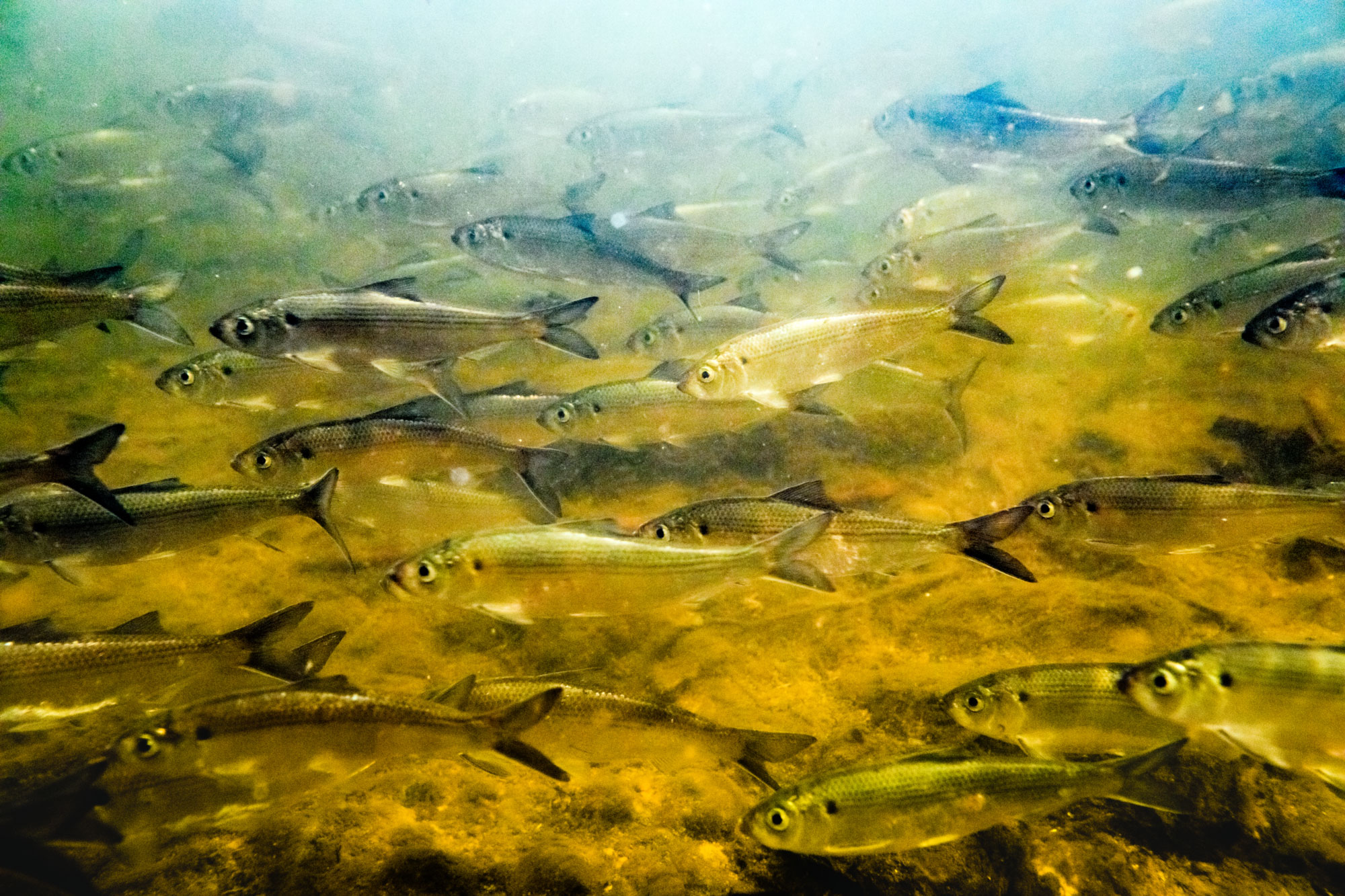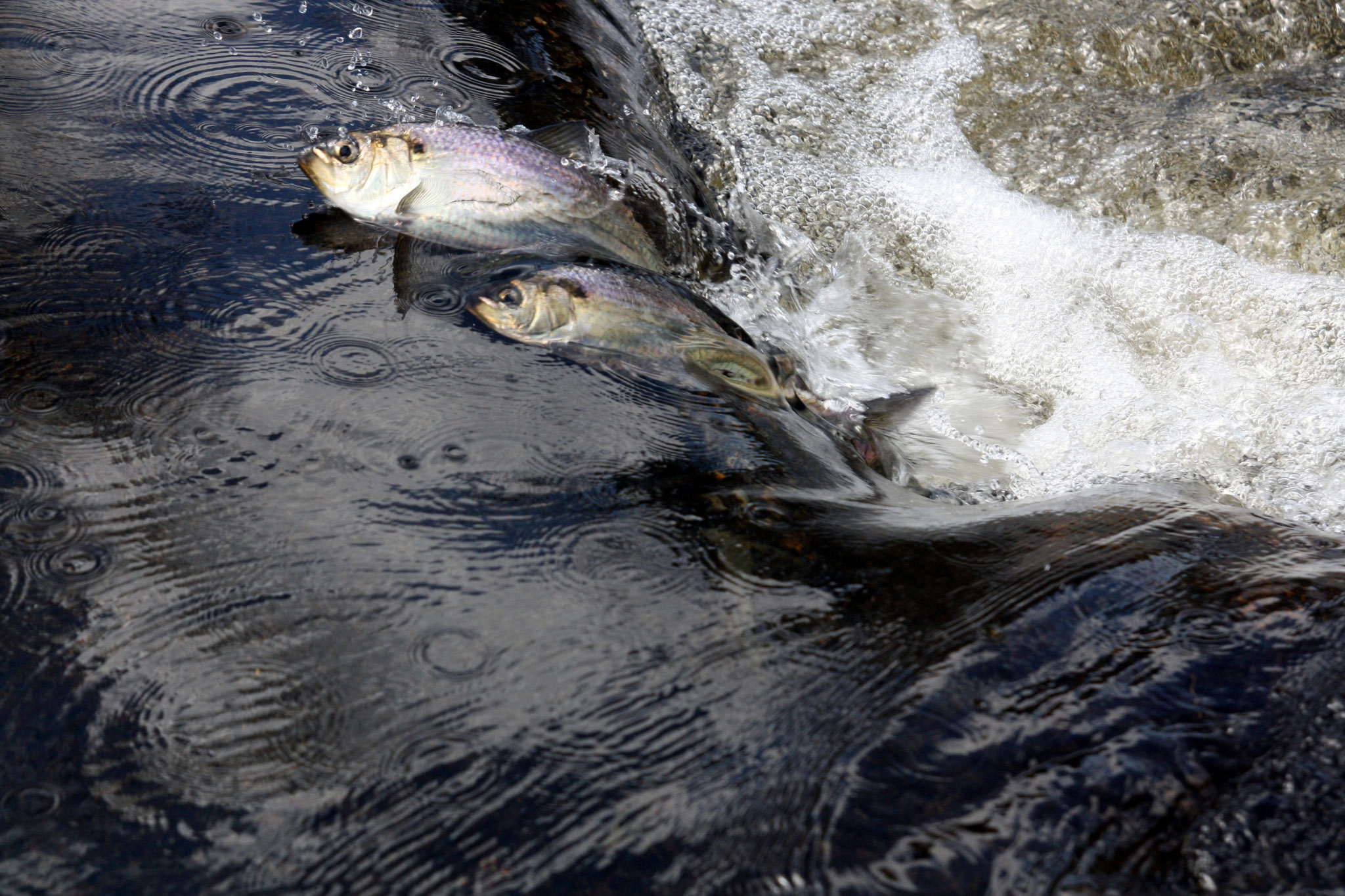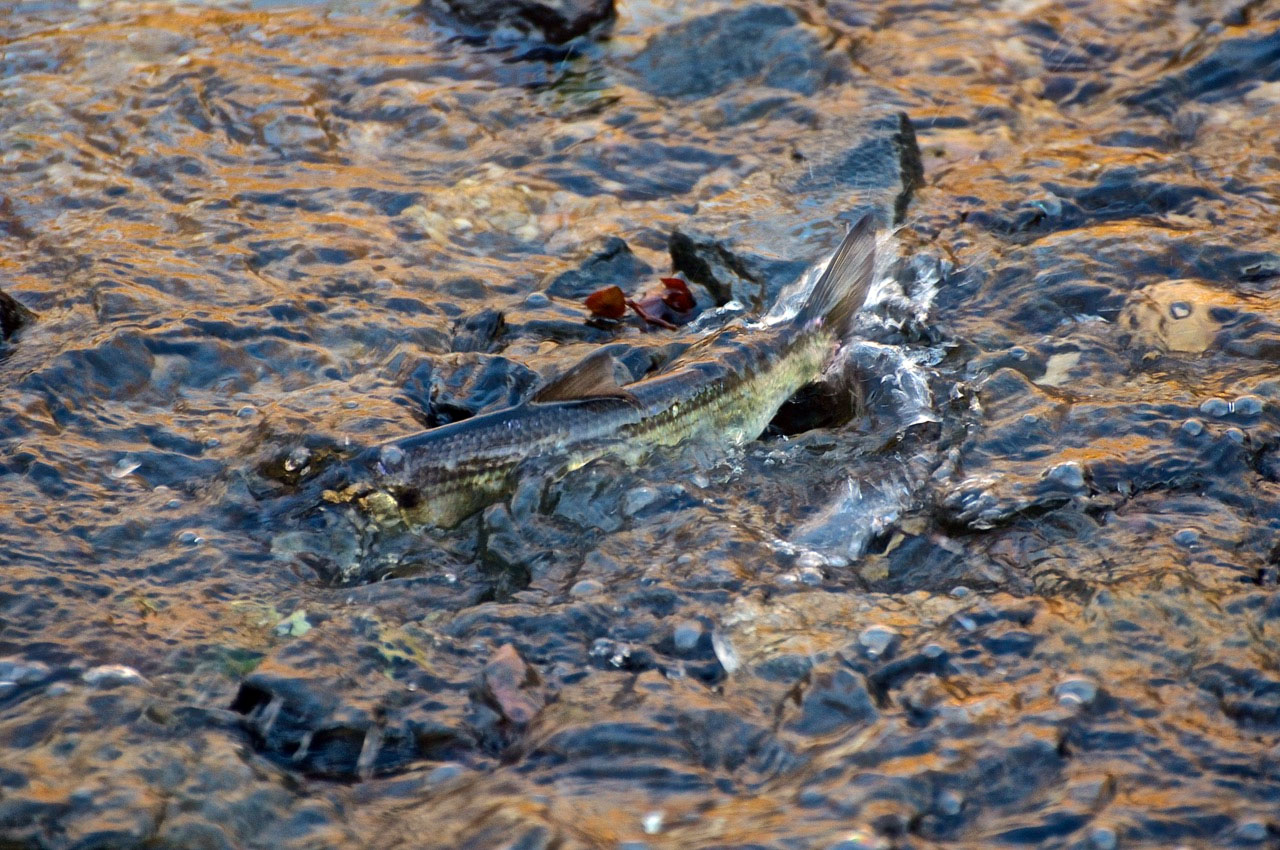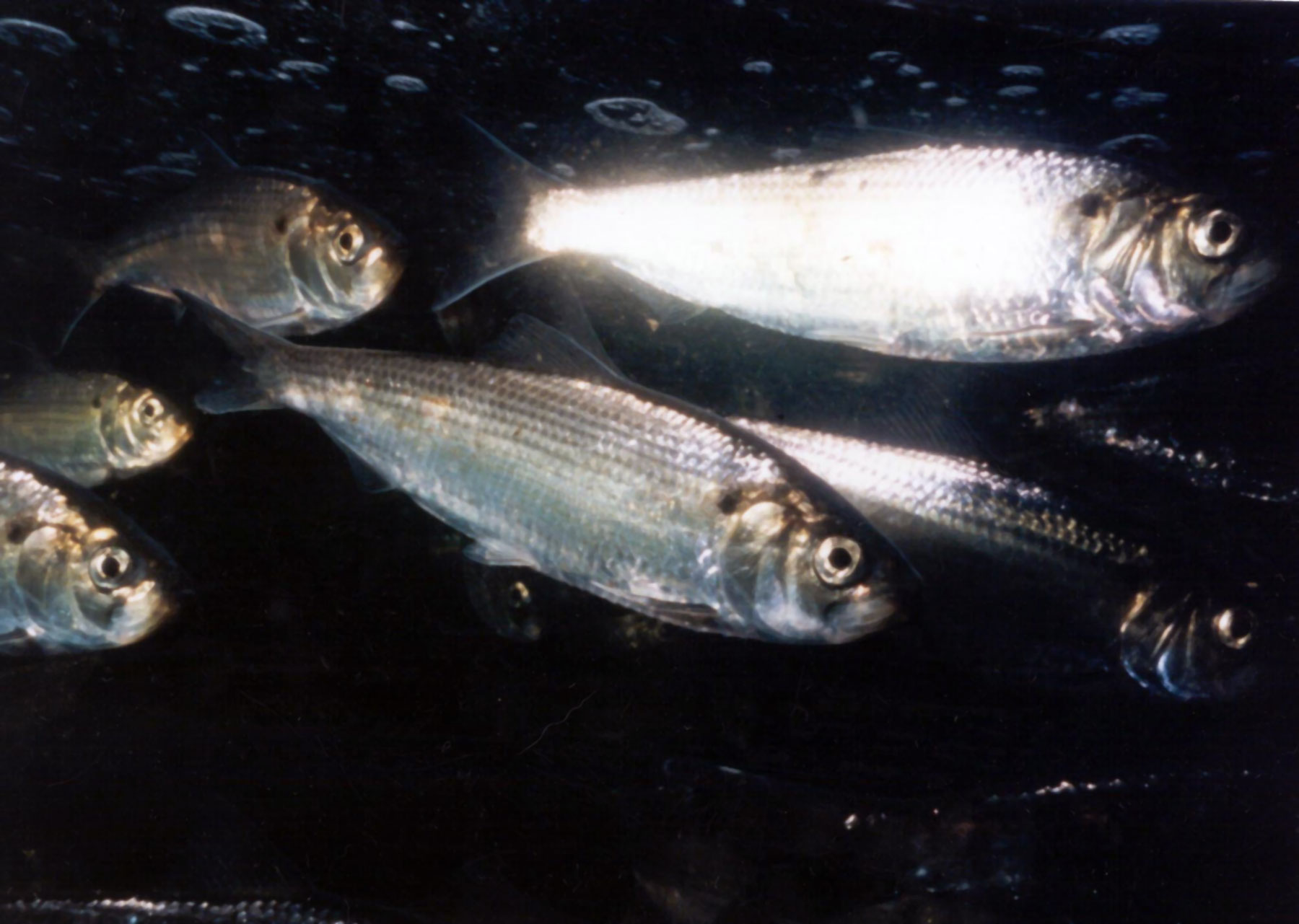River Herring
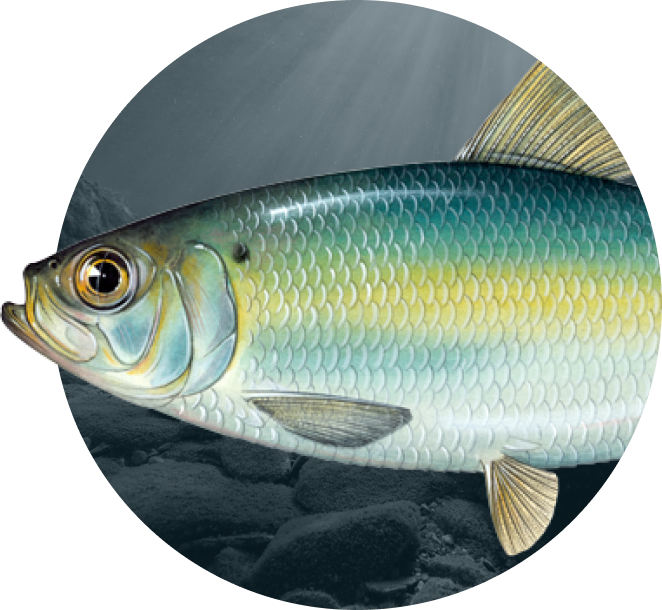
Latest News and Resources
-
Massachusetts Sustainable Fishery Management Plan for River Herring – Herring Brook, Pembroke, MA
-
Shad and River Herring Management Board Presentations — August 2025
-
2025 Summer Meeting Summary — Summer 2025
-
ASMFC Alternative Management Plan for Shad and River Herring in Florida
-
ASMFC Alternative Management Plan for River Herring for Georgia
-
Florida Alternative Management Plan for Shad and River Herring
-
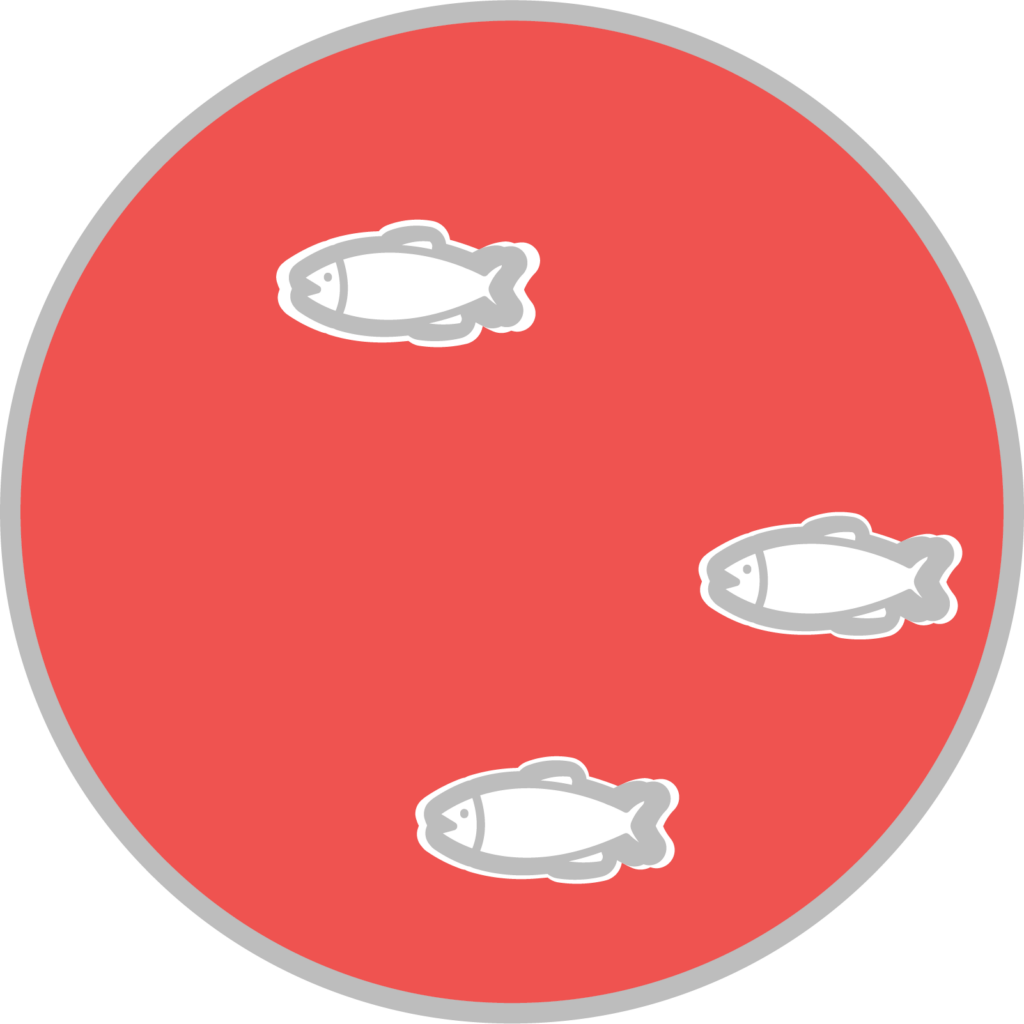
Population Abundance
Depleted

Total Mortality
Unknown
Current Status
Stock status based on 2024 benchmark assessment, with the species depleted on a coastwide basis and river-specific abundance and total mortality varying by river system. Amendment 2 established 2012 moratorium unless river-specific sustainability can be documented.
Meeting Calendar
Next Meeting
No events found
Contacts
- James Boyle IV, FMP Coordinator (JBoyle@asmfc.org)
- Management Board, Phil Edwards, Chair
- Technical Committee, Matt Jargowsky, Chair
- Advisory Panel, Pam Lyons Gromen, Chair
Species Information
River herring, including alewife and blueback herring, are migratory fish found along the Atlantic coast from Canada to Florida. They spend most of their lives in the ocean but return to freshwater rivers each spring to spawn. Once abundant, their numbers have declined due to barriers like dams, habitat loss, and overfishing. Today, efforts to protect and restore river herring include setting catch limits, improving river access for spawning, and ongoing research to better understand their movements. These conservation measures aim to help river herring populations recover, supporting both the ecosystems they thrive in and the fishing communities that depend on them.
Management
River herring are managed under Amendment 2 (2009) to the FMP for Shad and River Herring, which addresses concerns regarding declining river herring populations. Similarly to shad, the Amendment requires that states and jurisdictions develop SFMPs in order to maintain a commercial and/or recreational river herring fishery beyond January 2012. For 2019, approved River Herring SFMPs remain in effect for the states listed below. The remaining states and jurisdictions are required to prohibit commercial and recreational harvest.
Alternative Management Plans
Under Amendments 2 and 3 to the FMP, states may implement, with Board approval, alternative management programs for river herring and shad that differ from those required by the FMP. States and jurisdictions must demonstrate that the proposed management program will not contribute to overfishing of the resource or inhibit restoration of the resource. The Management Board can approve a proposed alternative management program if the state or jurisdiction can show to the Management Board’s satisfaction that the alternative proposal will have the same conservation value as the measures contained in the FMP. In August 2020, the Board approved the following alternative management plans.
Stock Status
The 2024 River Herring Benchmark Stock Assessment found the coastwide populations of both alewife and blueback herring were depleted relative to historic levels, with the habitat model indicating that overall productivity of all stock-regions for both species is lower than an unfished population in an unaltered landscape. The “depleted” determination was used instead of “overfished” and “overfishing” to indicate factors besides fishing have contributed to the decline, including habitat loss, predation and climate change.
In terms of recent trends, there is no clear signal for either species across the coast. Even within the genetic stock-regions, trends in abundance and mortality differed from river to river (see stock assessment overview to view river-by-river status), with some rivers showing increasing trends and low mortality rates, and others showing flat or declining trends and total mortality rates above the Z40%SPR reference point. Although very few significant trends overall were detected since 2009, the majority of indices of abundance for both alewife and blueback herring had a greater than 50% probability of being higher than they were when Amendment 2 was adopted. However, half of the blueback populations and 65% of the alewife populations had a greater than 50% chance of being above the Z40%SPR reference point, indicating total mortality on adult fish was too high.
In 2011, the National Resources Defense Council petitioned NOAA Fisheries to list river herring on the endangered species list throughout all or part of the species range. NOAA Fisheries conducted a status review and found that listing river herring under the Endangered Species Act was not warranted in 2013, and agreed to reevaluate the listing determination within five years. In June 2019, NOAA Fisheries released a new listing determination that found listing is not warranted for river herring at this time.
In 2015, the River Herring Technical Expert Working Group (TEWG), a group of scientists, industry representatives, conservation groups, tribal leaders and government officials with expertise in river herring conservation, convened to provide input and information on the River Herring Conservation Plan. The conservation plan was released by the Commission and NOAA Fisheries in May 2015 and sought to increase public awareness about river herring and foster cooperative research and conservation efforts to restore river herring along the Atlantic coast. Since completion of the conservation plan in 2015, river herring practitioners have continued to meet biannually to promote collaboration, information exchange, and outreach about these species. In 2020, the TEWG was renamed the Atlantic Coast River Herring Cooperative Forum (River Herring Forum), a name that reflects the voluntary meeting of river herring experts and practitioners for the purpose of sharing information and collaborating on efforts to study and conserve these species. In addition to a new name, the 2015 river herring conservation plan was updated and can be found here. More information can be found on the River Herring Forum webpage.
Commercial & Recreational Fisheries
River herring once supported the largest and most important commercial and recreational fisheries along the Atlantic coast. Since colonial times, the blockage of spawning rivers by dams and other impediments, combined with habitat degradation and overfishing, have severely depleted shad and river herring populations.
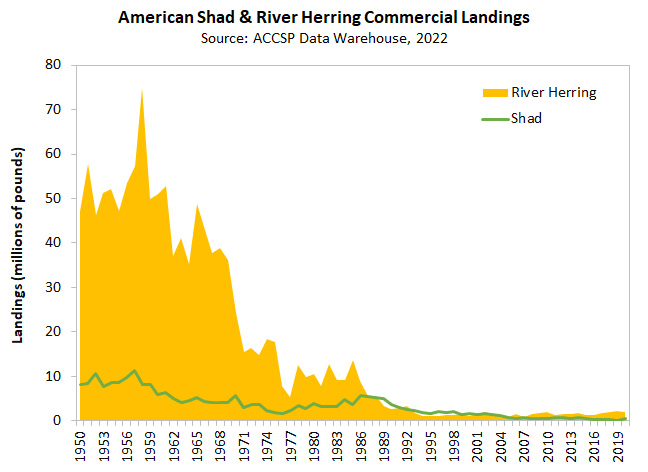
Commercial landings for these species have declined dramatically from historic highs. Commercial landings by domestic and foreign fleets peaked at 140 million pounds in 1969. Since 2000, domestic landings totaled less than four million pounds in any given year, with a historic low of 823,000 pounds occurring in 2006. In 2005, the directed at-sea fishery for American shad was closed, and subsequent landings from the ocean are only from the bycatch fishery. Approximately 110,027 pounds of American shad were landed in 2022, while an estimated 2.8 million pounds of river herring were landed.
Recreational catches of these species remain largely unknown. Anecdotally, recreational fishing for American shad is popular coastwide during the spring spawning run, but harvest information is unreliable. The Marine Recreational Information Program (MRIP) estimates numbers harvested and released by anglers, but estimates are imprecise, show few trends, and are deemed not useful for management purposes. Furthermore, MRIP concentrates its sampling strata in coastal waters and does not capture data on recreational fisheries occurring in inland waters. Few states conduct creel surveys or other consistent survey instruments (diary or log books) in inland waters to collect data on recreational shad and river herring catch. Some data are reported in the state chapters of the current stock assessment, but data are too sparse to conduct systematic comparisons of trends.
The Commission also continues to collaborate with New England Fishery Management Council (NEFMC) and the Mid-Atlantic Fishery Management Council (MAFMC) to address bycatch of these species in federal Atlantic herring and Atlantic mackerel fisheries. For Atlantic herring, the Councils set the annual catch cap for shad and river herring at 796,005 pounds in 2019 and have maintained the same limit through 2024. Under Framework 13 by the MAFMC, the catch cap in the Atlantic mackerel fishery increased from the 2019 cap of 196,211 pounds to 284,396 pounds for 2020 through 2022, and the MAFMC has maintained that cap level for 2023 and 2024.
Life History
River herring are anadromous fish that spend the majority of their adult lives at sea, only returning to freshwater in the spring to spawn. Historically, shad and river herring spawned in virtually every river and tributary along the Atlantic coast.
River herring is a collective term for alewife and blueback herring. Alewife spawn in rivers, lakes, and tributaries from northeastern Newfoundland to South Carolina, but are most abundant in the Mid-Atlantic and the Northeast. Blueback herring more commonly spawn in swiftly flowing rivers and tributaries from Nova Scotia to northern Florida, but are most numerous in waters from Chesapeake Bay south. Mature alewife (ages three to eight) and blueback herring (ages three to six) migrate rapidly downstream after spawning. Juveniles remain in tidal freshwater nursery areas in spring and early summer, but may also move upstream with the encroachment of saline water. As water temperatures decline in the fall, juveniles move downstream to more saline waters. Little information is available on the life history of juvenile and adult river herring after they emigrate to the sea and before they mature and return to freshwater to spawn.
News & Resources
Explore recent news, management updates, and scientific reports to gain a deeper understanding of ongoing conservation efforts and sustainability strategies.
-
The objective of this Sustainable Fishery Management Plan (SFMP) is to allow a reopening of the recreational river herring fishery in the Nemasket River, located within the towns of Middleborough and Lakeville, Massachusetts. This 2022 SFMP is an update of the original SFMP prepared cooperatively by Massachusetts Division of Marine Fisheries (DMF) and the Middleborough-Lakeville…
-
-
A summary of all the board meetings, press releases and motions from the 2025 Summer Meeting.
-
This alternative management plan for American Shad and Blueback Herring in Florida addresses American Shad management outside of the St. Johns River System and Blueback Herring in all state waters.
-
The purpose of Georgia’s alternative management plan for river herring is to allow waters to remain open. This plan is submitted to fulfill requirements of Amendment 3 to the Interstate Fishery Management Plan for Shad and River Herring (River Herring Management).
-
This Alternative Management Plan for American Shad & Blueback Herring in Florida addresses American Shad management outside of the St. Johns River System and Blueback Herring in all state waters.
-
The Atlantic States Marine Fisheries Commission’s Summer Meeting will be August 5-7, 2025 at The Westin Crystal City.
-
Advisory Panel Report on 2024 River Herring Benchmark Assessment; Consider Shad and River Herring Sustainable Fishery Management Plan (SFMP) and Alternative Management Plan (AMP) Updates (MA River Herring SFMP; FL Shad & River Herring AMP; GA American Shad SFMP and River Herring AMP); Elect Vice-Chair
-
The TC met via webinar on July 14, 2025, to review updates to the Sustainable Fishery Management Plans (SFMPs) for Massachusetts (river herring), Georgia (American shad), and Florida (American shad), as well as updates to the Alternative Management Plans (AMPs) for Georgia (river herring) and Florida (shad and river herring).
-
-
-
-
The Shad and River Herring Advisory Panel (AP) met via conference call and webinar on Monday, December 2nd, 2024, to continue discussing the results of the 2024 River Herring Benchmark Assessment and receive an update on the progress of the New England Fishery Management Council’s (NEFMC) Atlantic Herring Amendment 10. The AP will meet in…
-
-
Get Hooked on ASMFC News
Dive into the latest updates and catch all the important news by joining our newsletter mailing list. Stay in the loop with meeting agendas, fisheries management news, and more.
